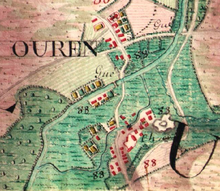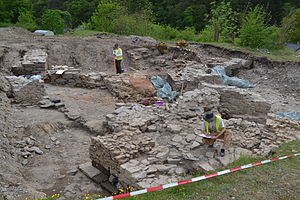Ouren Castle
| Ouren Castle | ||
|---|---|---|
|
Excavations by DG Archeology on the Ouren Castle Hill in spring 2014 |
||
| Creation time : | 12th Century | |
| Castle type : | Höhenburg, location | |
| Conservation status: | ruin | |
| Standing position : | Free nobles | |
| Construction: | Quarry stone | |
| Place: | Ouren | |
| Geographical location | 50 ° 8 '23.7 " N , 6 ° 8' 0.2" E | |
|
|
||

The Castle Ouren is the ruins of a hilltop castle in Ouren in the German-speaking part of Belgium . It was the ancestral seat of the noble family of the Lords of Ouren .
The complex, which dates back to the 11th century, was originally a multi-part, fortified castle with a palace , a keep and a castle chapel in the higher northern area of the castle hill. In the lower southern area was the outer bailey with the farm buildings belonging to the castle. In the late Middle Ages , the castle gradually lost its fortification character in favor of increasing living comfort for the aristocratic residents. The conversion from a castle to a palace was carried out through renovation phases in 1535 and 1615 . A surviving drawing of a lost watercolor by Joseph-Ernest Buschmann (1814–1853) from the mid-19th century shows the complex as a - presumably romanticized - baroque palace. After the destruction by French revolutionary troops in 1794, the castle became uninhabitable and after 1845 it was almost completely demolished.
Location and topography
The castle ruins are located in the southern part of East Belgium , near the border with Luxembourg . The castle plateau is located on a slate rock that protrudes like a spur into the Ourtal. The castle hill is surrounded by the Our to the north, west and east . Access to the castle plateau is via a slight depression in the south. On both sides of the river there are predominantly wooded mountain ranges of the Eastern Ardennes with altitudes of approx. 400 to 539 meters above gauge Ostend (m OP)
history
The exact time when Ouren Castle was founded is not known. The lineage of the noble lords of Ouren is mentioned in documents from the 11th century. The castle as such is mentioned for the first time in a document at the end of the 12th century (1190–1198), in which Heinrich von Sponheim had his share of the castle leaned on by Archbishop Johann I of Trier .
After the male lineage died out, the castle and the lordship fell to the Malberg family through marriage in 1365 . In the last decade of the 14th century, the castle was pledged to Archbishop Werner von Falkenstein of Trier . As a result, during a feud between the Archbishop and the Lords of Aremberg in 1394 , the castle was besieged by Eberhard von der Mark and his son Johann and finally occupied, but in the same year it was recaptured by the Archbishop's soldiers. Ouren castle and estate remained in the sole possession of the Malberg family until 1517.
Also by marriage in 1517, the castle and manor were divided between the Malberg and Giltingen houses. The property was challenged in court in 1614, as Gerhard von der Horst , who had been married to the daughter of Gerhards von Malbergs since 1583, also claimed the title.
In the 17th century the castle and the manor came into the possession of a von Ouren family who called themselves the Lords of Ouren, Tavigny, Limbach and Feilen. In 1680 his son Johann Franz Ignaz von Ouren leased the castle and estate to Peter de la Branche. In 1690 the lease was extended for a further six years.
With the marriage of Maria Sidonie von Ouren (* 1643) to Johann Lambert von Dobbelstein, the property is divided again. After the death of Veronika von Ouren, the widow of Johann Franz Ignaz von Ouren, the castle and the lordship fell entirely to the Dobbelstein family after 1733. With Karl August von Dobbelstein this line also died out.
Ouren Castle was last owned by the Baron von Taverne.
The castle was destroyed by French revolutionary troops . In 1798 rebels holed up in the ruins during the so-called clapper war . Ouren Castle was auctioned twice for demolition in 1844 and 1845 and finally closed.
The only known depiction of Ouren Castle is a pen drawing based on a lost watercolor by Joseph-Ernest Buschmann from the first half of the 19th century.
The castle ruins today
The former castle is now a ground monument . Above ground, only individual remains of the foundation and parts of the former surrounding wall are preserved. Due to the poorly preserved written sources, knowledge about the building history and historical development of the castle and the place can only be obtained with archaeological methods.
From 2013 to 2015, the Archaeological Service of the German-speaking Community of Belgium carried out excavations on the castle hill. This was preceded by superficial and little-documented research by the Société Archéologique du Sillon Mosan (SOS fouilles) in autumn 1988 and January 1989.
literature
- Cynthia Colling: Ouren Castle in the German-speaking Community of Belgium. A piece of Luxembourg history beyond the national border. In: Archaeologia luxemburgensis. Bulletin du Center national de recherche archéologique. No. 3, 2016, ISSN 2354-5526 , pp. 129-149 ( digitized version ).
- Kurt Fagnoul: Georg Hartmann and the castles between the Venn and Schneifel. In: Between the Venn and the Schneifel. Journal of history, folklore and culture. Volume 3, 1967, pp. 97-98.
- Hubert Jenniges: The auction of Ouren Castle 1845/1846. In: Between the Venn and the Schneifel. Journal of history. Volume 10, 1974, pp. 177-178.
- Karl Leopold Kaufmann : The Malmedy Border District 1815–1865. Röhrscheid, Bonn 1963.
- Heribert Reiners : The art monuments of Eupen-Malmedy. L. Schwann, Düsseldorf 1936, pp. 389-391.
- Georg Strasser: The relationship between the von der Fels family and the city of Trier from approx. 1300 to 1450. In: Trierische Chronik . New series XI, 1914/15, pp. 34-38.
- Bernhard Willems: The Lordship of Ouren. In: Between the Venn and the Schneifel. Volume 1, 1965, pp. 6-7.
Web links
Individual evidence
- ↑ Trieric Chronicle New Series IV, 1819. P. 99.
- ↑ Drawing of the watercolor after Buschmann approx. 1840-1850.




